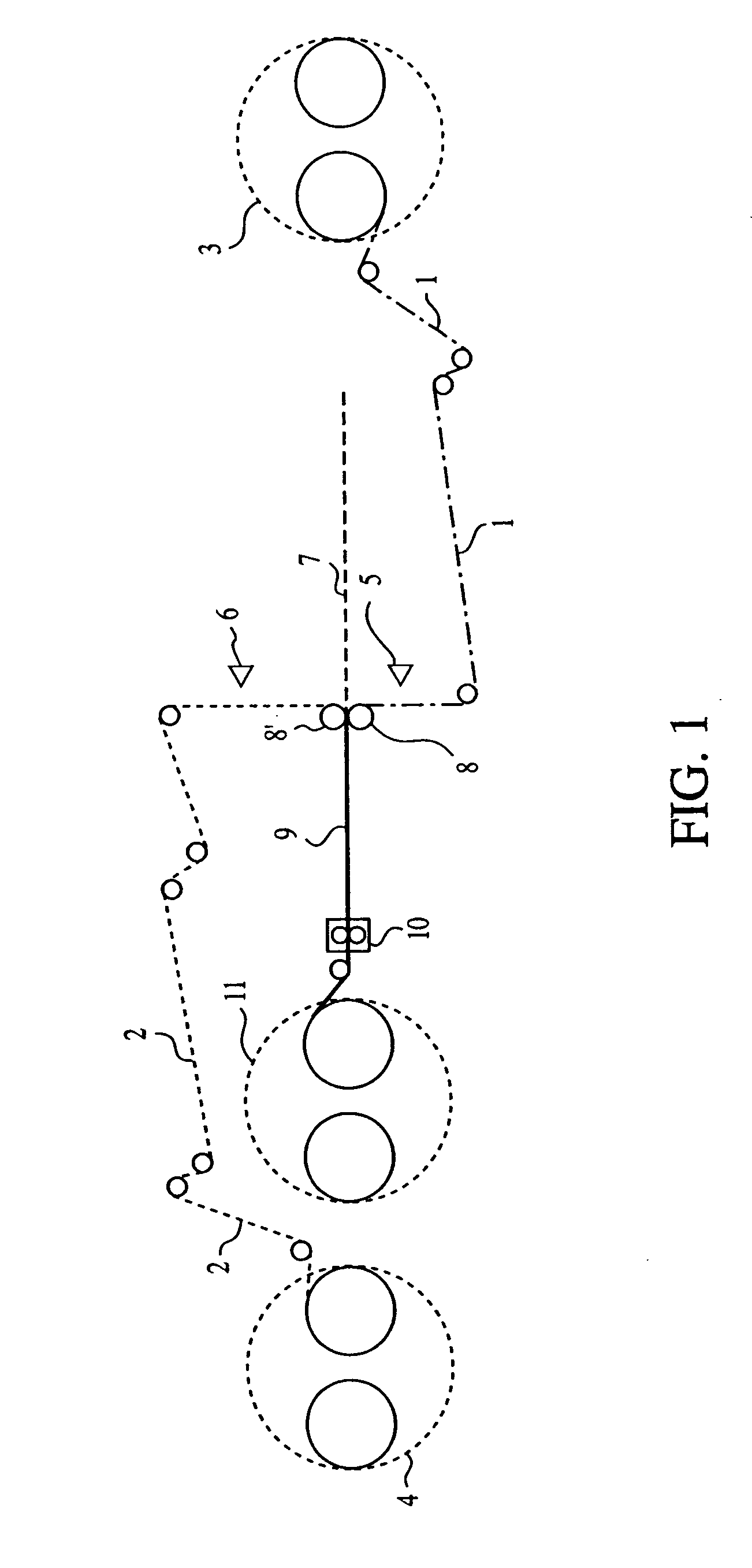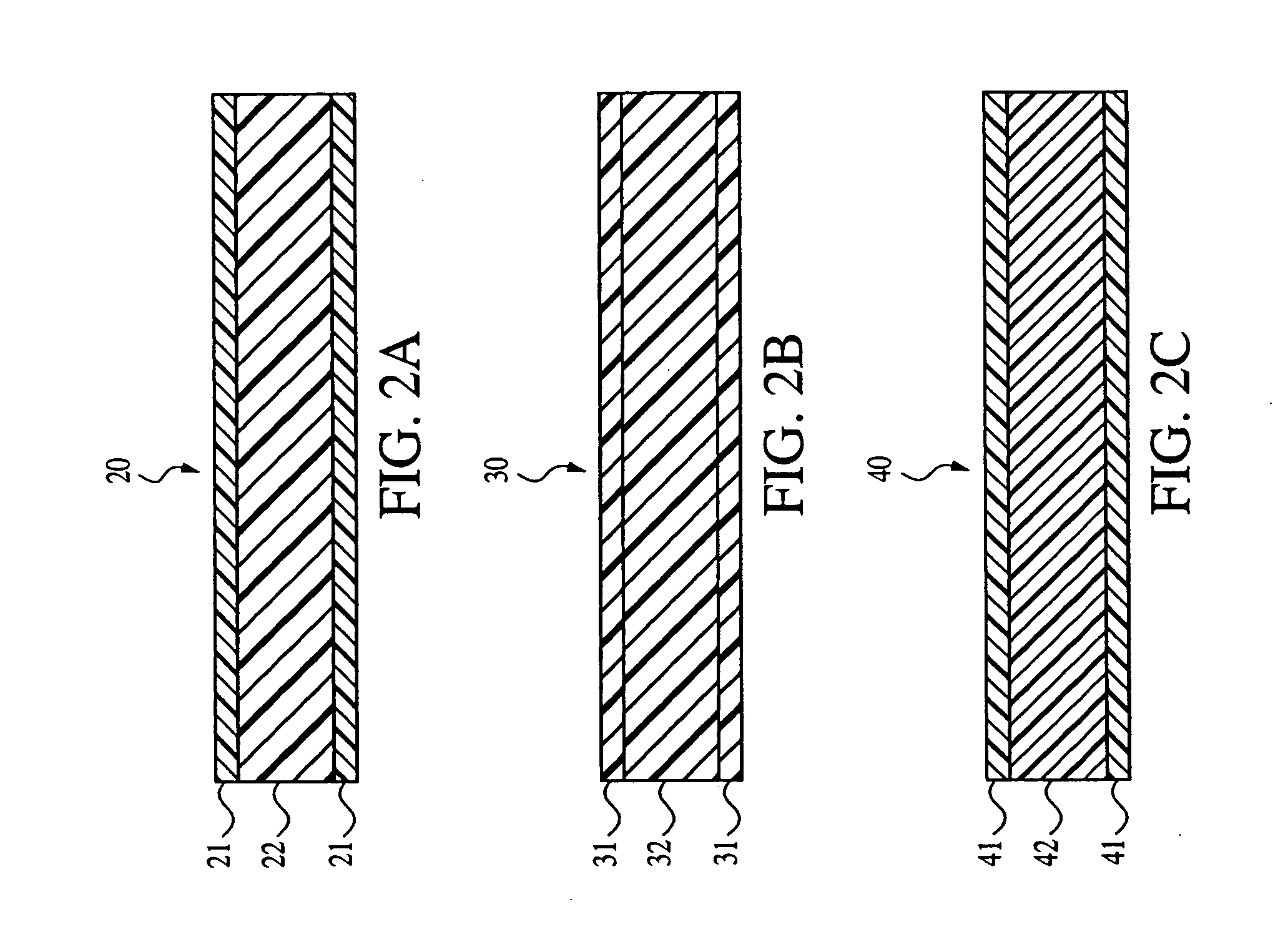Ethylene oxide sterilizable, low cost nonwoven laminates with high wet peel stregth and improved barrier properties
a technology of ethylene oxide and nonwoven materials, applied in the field of composite laminate structure, can solve the problems of product wet peel strength substantially reduced, and achieve the effects of improving performance, adhesion and softness or drapery, and improving wet peel strength
- Summary
- Abstract
- Description
- Claims
- Application Information
AI Technical Summary
Benefits of technology
Problems solved by technology
Method used
Image
Examples
example 1
[0020] A three layer (A-B-A) co-extruded film was produced. Core layer (B) was made from a LDPE (designated PE 1017). The linear low density polyethylene is commercially available from Chevron Phillips Chemical Company, The Woodlands, Tex. The nominal properties of PE 1017 resin (MSDS No. PL001) are a melt index of 7.0 gms / 10 min (ASTM D1238-57T) and a density of 0.917 gms / cc (ASTM D1505-60T). It is characterized by excellent processability, high temperature stability and low neck-in. The color is translucent to clear.
[0021] The outer layers (A) were made using MARLEX EX01D resin, which is commercially available from Phillips Sumika Polypropylene Company (now Chevron Phillips Chemical Company, The Woodlands, Tex.). MARLEX EX01D is a blend of polypropylene and polyethylene (approximately 85% polypropylene and 15% polyethylene). Its nominal resin properties are density—0.906 g / cc (ASTM D1505); melt flow (230° C.)—35 g / 10 min (ASTM D1238); melt point—167° C. (ASTM D3418); and crystall...
example 2
[0025] As a comparative example, a three layer extruded film with each layer (A-A-A) comprising only Chevron's PE 1017 low-density polyethylene was laminated to the same PP spunbonds as in Example 1 with similar processing conditions. Each side of the cast film was laminated to a PP spunbond substrate using Fuller NW 1023 hot melt adhesive as in the previous example.
[0026] Properties of the constituent layers and the results of testing of both examples' wet / dry inner peel strength and blood barrier properties are shown in TABLE 1:
TABLE 1Example 1Example 2AfterAfterAgingagingAt Time of(Approx. 1After EtOAt Time of(Approx. 1After EtODate of TestingUnitsProductionmonth)SterilizationProductionmonth)SterilizationSpunbondgsm3030Weight (outerlayer)Spunbondgsm2020Weight (innerlayer)Film Weightgsm1818Adhesive add-ongsm33(outer layer)Adhesive add-ongsm22(inner layer)Handelometer,grams8986MDHandelometer,grams4147CDDry Inner Peelg / in8113715774138108Strength (CD)Wet Inner Peelg / in9719317990 3...
example 3
[0027] A three layer (A-B-A) co-extruded film was produced. Core layer (B) was made from a blend of a 30% LLDPE (designated MarFleX™ PE 7235) and 70% LDPE (designated PE 1017). The nominal properties of MarFleX™ PE 7235 resin are a hexane copolymer and commercially available from Chevron Phillips Chemical Company, The Woodlands, Tex. The nominal properties of MarFleX™ PE 7235 resin are a melt index of 3.5 gms / 10 min (ASTM D1238E) and a density of 0.9235 gm / cc (ASTM D 1505). PE 1017 resin is described in Example 1. The blending is done in-line by using gravimetric feeders and the blend, along with other additives such as pigments, is then fed into the extruder B. The outer layers (A) were made using a polypropylene resin designated MARLEX EX01D resin as in Example 1.
[0028] To produce the co-extruded film of the above example, Marlex EX 01 D resin was fed from extruder A, while the blend of PE 7235 and LDPE 1017 resins was fed from extruder B. The two resin stocks are then fed to a t...
PUM
| Property | Measurement | Unit |
|---|---|---|
| Fraction | aaaaa | aaaaa |
| Fraction | aaaaa | aaaaa |
| Time | aaaaa | aaaaa |
Abstract
Description
Claims
Application Information
 Login to View More
Login to View More - R&D
- Intellectual Property
- Life Sciences
- Materials
- Tech Scout
- Unparalleled Data Quality
- Higher Quality Content
- 60% Fewer Hallucinations
Browse by: Latest US Patents, China's latest patents, Technical Efficacy Thesaurus, Application Domain, Technology Topic, Popular Technical Reports.
© 2025 PatSnap. All rights reserved.Legal|Privacy policy|Modern Slavery Act Transparency Statement|Sitemap|About US| Contact US: help@patsnap.com



